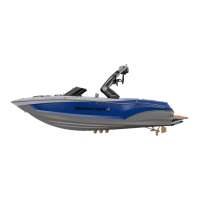2023 OWNER’S MANUAL
/
424
2. Follow the instructions on the brake fluid container. Avoid shaking
the brake fluid container, and pour fluid slowly to minimize air
entrapment. Let the fluid in the reservoir stand until it is completely
free of air bubbles.
IMPORTANT: Before bleeding the brake lines, bleed the actuator
master cylinder. This is mainly required if a new master cylinder
has been installed, or if the master cylinder was run dry or is low
on fluid. To do so, remove the plastic access cover on the top of
the actuator housing and insert a flat blade screwdriver between
the rear bracket/tab and the fixed tab. The fixed tab is between the
rear bracket/tab and the front (E-brake release) tab. While holding
down the front tab, and using a slow/controlled motion, cycle the
screwdriver fore-aft to pump the master cylinder push rod.
3. Start the bleeding procedure on the brake farthest from the
master cylinder.
4. At the brake assembly, connect a transparent bleeder hose to the
bleed screw fitting on the caliper and submerge the free end into a
container partially filled with brake fluid. Do not reuse this fluid.
5. The first person should stroke the push rod slowly while holding
the safety release bracket down. The second person opens the
bleed screw fitting. Then close the bleed screw fitting BEFORE the
first person SLOWLY releases the push rod. Repeat this procedure
until the fluid expelled from the bleeder hose is free of air bubbles.
Remember to always tighten the bleeder screw before releasing the
push rod. During this procedure, the master cylinder reservoir fluid
level must be maintained at no less than half full.
6. Repeat Steps 4 and 5 for the other brake, as well as the brakes on
the front axle of tandem axle trailers, or the center then finally the
front on triple axle trailers. If installation is on a tandem-axle or
after backing up and replace in the coupler position to lock
the coupler. Failure to do so will cause the loss of brake power
when the trailer is towed.
The reverse lockout option must only be used when moving in
reverse. Immediately remove the pin prior to towing and fully
insert it into the coupler latch.
Manual Bleeding of Brakes
The following procedure should be performed only by skilled
mechanics. MasterCraft recommends that it be completed only by
an authorized MasterCraft dealer.
Check that all hydraulic fittings are secure. Read and
understand all instructions before starting. Two people are
required for manual bleeding.
1. Remove the master cylinder reservoir cap and fill the reservoir with
brake fluid. Use either DOT 3 (preferred) or DOT 4 automotive brake
fluid. DO NOT USE DOT 5 BRAKE FLUID. DOT 5 FLUID WILL DAMAGE
THE SEALS IN THE ACTUATOR AND CALIPERS CAUSING FAILURE OF
BRAKES THAT COULD LEAD TO INJURY OR DEATH.
(See recommended brake fluid information in this section of the
Owner’s Manual.)

